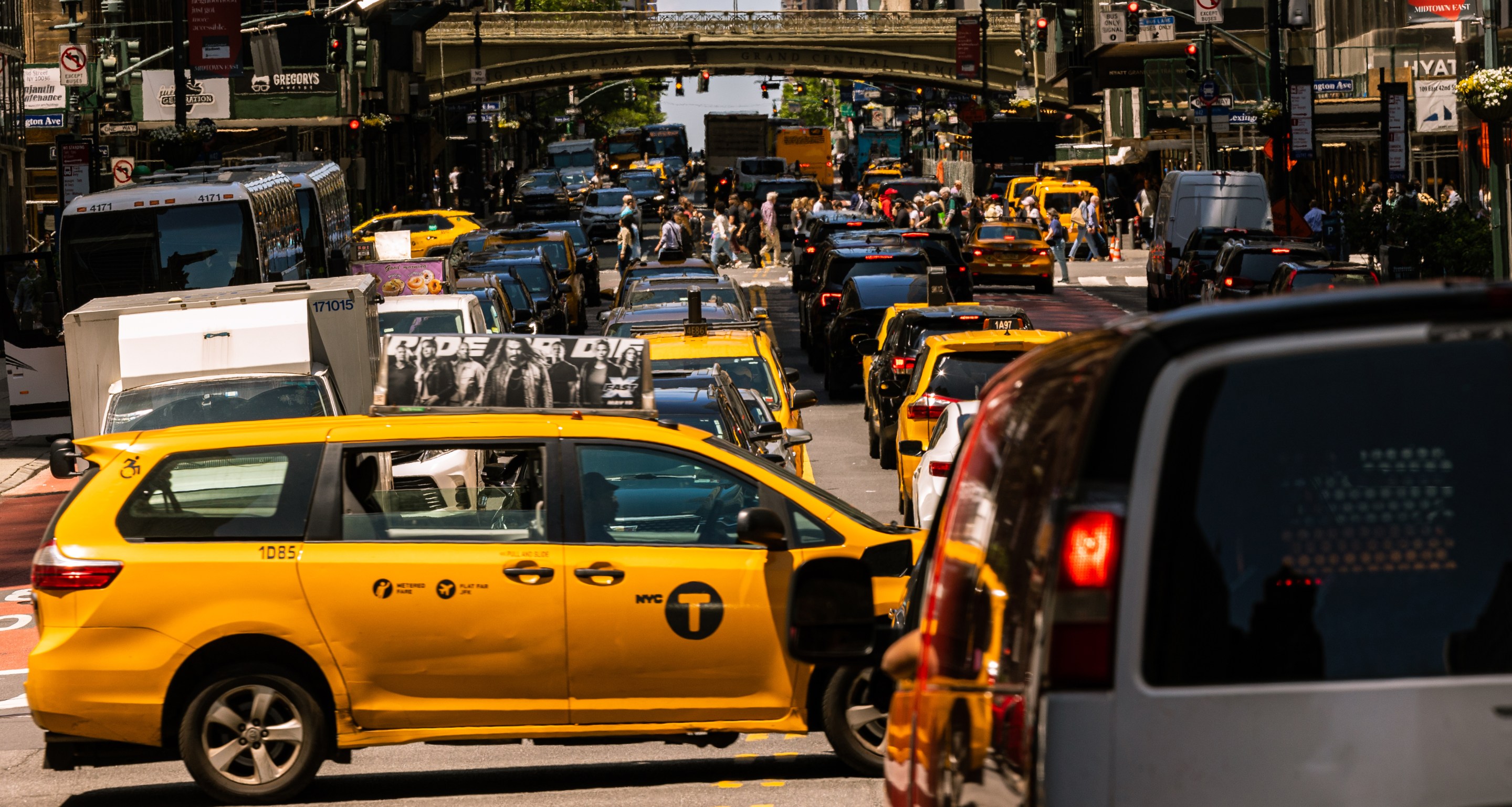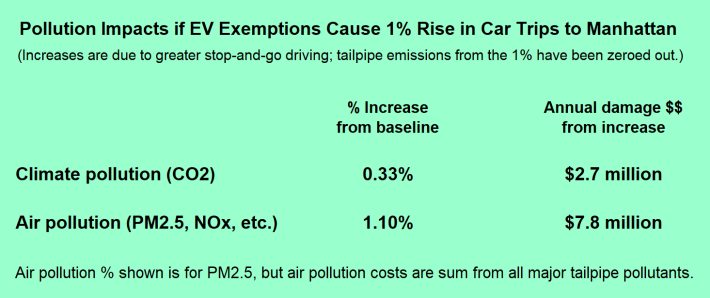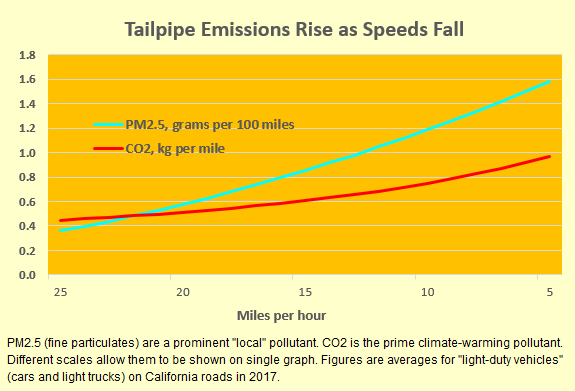KOMANOFF: Beware the EV Congestion Boomerang
2:32 PM EST on February 8, 2021

This is what a policy failure looks like.
It’s looking all but inevitable that electric vehicle backers will demand that EVs be exempted from congestion pricing tolls, as a way of motivating motorists to switch to “clean” electrics. Yet doing so will increase traffic volumes, cutting into the air and climate gains from tolling auto trips into the heart of New York City.
No exemptions for electric cars were written into the 2019 Albany legislation authorizing congestion pricing. No discounts, even.
That was a strong tide our legislators bucked. EV purchasers enjoy federal tax breaks worth up to $7,500, and New York State’s Drive Clean tax credit sweetens the pot with an extra $2,000. Some states, allow solo drivers of electrics to use HOV lanes. To raise funds, a New England climate advocacy group raffles off a Tesla. Yet congestion pricing, sticking to its aim of cutting traffic congestion, is unblemished by an EV carve-out.

Maintaining this paywall could be hard when congestion pricing gets rebooted. Vehicle electrification has broad political appeal. Drivers keep their pole position. Net emissions decline as the power grid decarbonizes, pleasing climate and environmental advocates. GM is complaisant, judging by its promise last month to stop selling combustion cars after 2035. The United Auto Workers are on board with EVs as well.
So am I, up to a point. Key to big-city sustainability is ensuring that the rush to electrify not lead to exempting EVs from congestion tolls and other road charges.
Downsides of EV toll exemptions
Some downsides of exempting electric vehicles from New York’s congestion tolls are obvious: shriveled revenue pots for public transit; lesser reductions in gridlock; economically regressive outcomes, given that EV buyers skew affluent.
Other downsides are subtler. Electric car refueling doesn’t pay into New York’s Petroleum Business Tax, a wholesale-level, statewide fee on gasoline and diesel fuel that has helped fund the MTA for almost 40 years. Ditto the state gasoline and diesel excise tax. (Wonky details here.)
And there’s this: granting electric vehicles toll exemptions or discounts will spawn upward bumps in emissions.
That’s without counting the “upstream” power plant emissions from generating electricity to recharge the batteries. Here I’m simply addressing the rise in tailpipe emissions from the combustion vehicles still on the road.
Exempting EVs will push up relative emissions because increases in vehicular volumes intensify stop-and-go driving — a condition that degrades engine efficiency. That means higher emissions of carbon dioxide, the main climate pollutant, as well as of “local,” toxic pollutants like fine particulates (PM2.5).
Quantifying pollution increases if EVs are exempted
The building blocks to quantify the connections between lower speeds and higher emissions have been in my BTA spreadsheet (downloadable Excel file, see Emissions and Speed-CO2 tabs) for years. For toxic pollutants, the BTA uses speed-emission equations developed by the California Air Resources Board. For carbon dioxide, it employs empirical relationships between vehicle speeds and gas mileage derived by engineers at U-C Riverside’s Center for Environmental Research and Technology.
The graph below depicts the tendency of emissions to rise as car speeds fall. By linking those emissions relationships with separate curves translating higher traffic volumes into lower vehicle speeds, the BTA is able to estimate how much emissions rise when extra vehicles are added to the traffic stream.

In the past I’ve used those linkages to estimate reductions in CO2 and particulates from congestion pricing. This month I used them to test the emissions impacts of compounding New York City’s already congested traffic with EVs.
I programmed the BTA to raise the number of daily trips into the congestion charging zone (the Manhattan Central Business District, south of 60th Street) by an arbitrary but easy to grasp one percent, while treating the new trips as if they were made in zero-emission EVs.
Using pre-pandemic baseline volumes of 617,300 daily trips, the one percent rise equates to an increase of 6,173 trips to the CBD each day. I zeroed out their tailpipe emissions, effectively rendering them as trips in electric vehicles.
Meanwhile, the traffic-emissions connection in the model converts the incremental congestion from the extra trips into incrementally greater emissions from the baseline of 617,300 non-electric cars, taxis, trucks, Ubers and Lyfts.
The results? Yearly carbon dioxide emissions from those 617,300 CBD trips rise by 26,650 metric tons, a bump from baseline emissions of one-third of one percent (0.33 percent). Emissions of fine particulates (PM2.5), the tailpipe pollutant most conspicuously implicated in heart and lung disease and dementia, increase by 822 kilograms, a rise of 1.1 percent. (The greater sensitivity of PM2.5 emissions to the decreased speeds is consistent with the steeper curve for fine particulates in the graph.)
These increases are just a taste and the tip.
They’re a taste of possible increases in emissions if EVs are granted free passes around congestion tolls. If the resulting rises in car trips to the CBD relative to the decreases expected from congestion pricing exceed the 1 percent rise assumed here, the augmented pollution would be proportionate to the increases. And that’s without counting reduced funding for public transit from lessened congestion revenues.
Moreover, the emissions are just a tip of the veritable iceberg of “negative externalities” (side effects) of maintaining or even increasing car volumes and use — a litany that, as readers know, ranges beyond even disabled climate and toxic air to encompass car crashes, household financial straits and so much more.
An emerging issue is lithium, a metal that will have to be mined in burgeoning quantities to fuel EVs, setting the state for widespread ecological destruction, as I describe in this new dispatch for the Carbon Tax Center.
Charles Komanoff is a national expert on congestion pricing and traffic modeling, and is the former head of Transportation Alternatives. He is a longtime Streetsblog contributor. Reach him at komanoff@gmail.com.
Read More:
Stay in touch
Sign up for our free newsletter
More from Streetsblog New York City
OPINION: Congestion Pricing Will Help My Family Get Around As We Navigate Cancer Treatment
My partner was recently diagnosed with cancer. Congestion pricing will make getting her to treatment faster and easier.
EXCLUSIVE: OMNY Debuts on Fair Fares After Delays
The long-awaited Fair Fares expansion will launch as a three-month pilot for a few dozen riders.
Good Luck Docking Your Citi Bike In Lower Manhattan
Many frustrated commuters to Lower Manhattan opted to simply abandon their Citi Bikes undocked due to the lack of open spots in the area.




